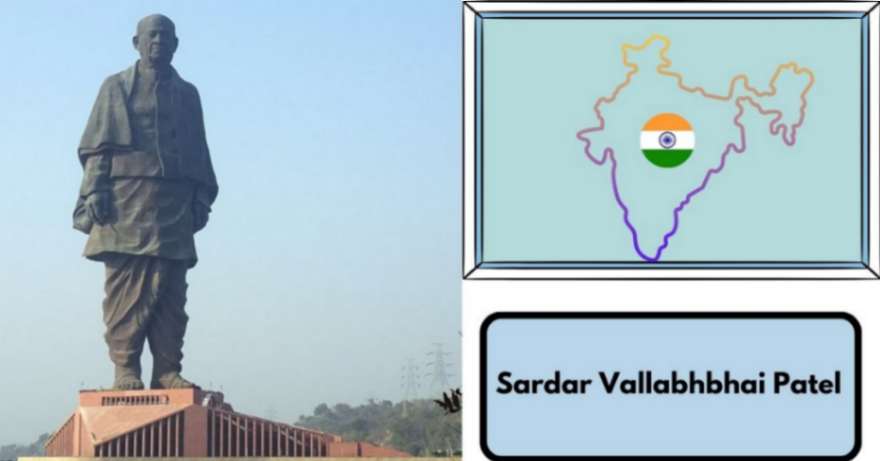Table of Contents
Iron Man of India
Introduction: Sardar Vallabhbhai Patel, known as the Iron Man of India, was born in Gujarat. Sardar Patel united India with courage, devotion, and determination while serving as India’s home minister. In this 750-word essay, we examine many facets of Sardar Vallabhbhai Patel’s life in detail.
Sardar Vallabhbhai Patel,early life and education
Vallabhbhai Patel was born in Nadiad, Gujarat on October 31, 1875. His parents, Jhaverbai and Ladbai, were peasants. Vallabhbhai was a hard-working boy and helped his father in the fields.
He completed his high school education in 1897 and began studying for the bar exam. The financial conditions of the family delayed his wish for higher studies. In 1904, he married Dayabhai, and in 1909, she passed away, leaving a 5-year-old daughter and a 3-year-old son. To serve his motherland, he decided not to marry again. In 1910, 36-year-old Sardar Vallabhbhai Patel traveled to England to pursue a three-year Law degree.
After earning a first-class degree in law in 1913, he returned to India to begin practicing law. The British Government offered lucrative job offers to Vallabhbhai, but he turned them all down. He disliked the laws and the British government. He challenged the unfair treatment of Indian advocates in the legal system and invalidated several laws. In Ahmedabad, Vallabhbhai Patel went on to become a prosperous lawyer. He fought for the rights of farmers, such as an unjustifiable tax, and got the title of ‘sardar’. He gave his children a modern education by sending them to an English-medium school.
Sardar Patel was elected to the Ahmedabad municipality as a councillor on January 5, 1917 and subsequently in 1922, 1924, and 1927. He completely overhauled and upgraded the system, extending the city’s sanitation, drainage, and electrical supplies. Significant reforms were made to the education system also.
Sardar Vallabhbhai Patel,Participation in National Movement
Mahatma Gandhi appointed him as his deputy commander to lead the Kheda Satyagraha in 1918, marking an important phase in his life. Gandhiji declared satyagraha against Roulette bill act in 1919.To support the fund for the independence struggle, Sardar Patel and Gandhiji amassed millions of rupees and ornaments. He was very particular about not misusing the funds.
Because Sardar Vallabhbhai Patel took part in the well-known Salt Satyagraha that Mahatma Gandhi organized, he was imprisoned in 1930. He changed many people’s lives during the “Salt Movement” with his inspirational speeches, and those individuals went on to play a significant part in the movement’s success. After Mahatma Gandhi and Lord Irwin, the Viceroy of India at the time, signed an agreement called the Gandhi-Irwin Pact, Sardar Patel was set free in 1931. He became the president of the Indian Nation Congress’s Karachi Session in 1931. He was arrested several times by the British after that.
The Congress Party was organized by Sardar Patel ahead of the 1937 general elections. Congress had won the election. Sardar Patel was an outspoken supporter of Hindu-Muslim harmony. It was decided to form an interim government in September 1946. His name was suggested by the majority of congressional committees for the position of Congress President. Gandhiji supported Nehru.
On June 25, 1947, the States Department was founded under the direction of Sardar Patel. VP Menon served as secretary. On August 15, 1947, Sardar Patel became the first Deputy Prime Minister and Home Minister of an independent India. He was also placed in charge of the Ministry of Information and Broadcasting.
Sardar Patel crushed the rebel forces with his iron grip. Among the princely states that were reluctant to join the Indian Union were Hyderabad and Junagadh. These states joined the Indian Union as a result of Patel’s diplomatic efforts and military intervention.
The Iron Man of India drew his last breath on December 5, 1950.
Sardar Vallabhbhai Patel,the Symbol of National unity
Since 2014, October 31 has been recognized as National Unity Day in honour of Sardar Patel, who received the Bharat Ratna in 1991. The world’s tallest statue, the “Statue of Unity,” was dedicated to the country on October 31, 2018, by Prime Minister Narendra Modi. Standing at a height of 182 meters, the Vindhyachal and Sapura hills in Kevadia, Gujarat, provide a striking backdrop.
Conclusion
Sardar Vallabhbhai Patel fought against British laws in India. He improved Ahmadabad’s infrastructure and education, was chosen by Mahatma Gandhi for the Kheda Satyagraha, and later became President of the Indian National Congress. In 1947, the government was formed, with Sardar Patel as the first Deputy Prime Minister and Home Minister of an independent India. He united the nation with courage and determination, defeating rebellious forces and reuniting princely states.
FAQ
who is the iron man of India?
Sardar Patel, who as India’s first home minister brought the country together with courage, devotion, and resolve, is known as Iron Man of Bharat
When is National Unity Day celebrated in India?
In honour of Sardar Patel, who as India’s first home minister brought the country together with courage, devotion, and resolve, October 31 has been declared National Unity Day since 2014.

